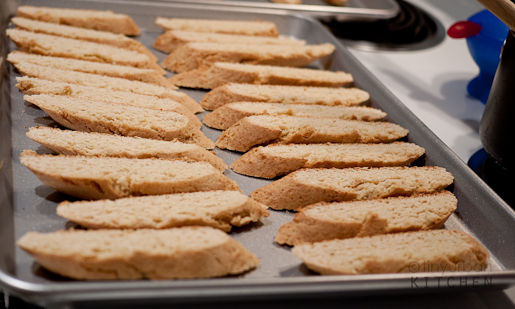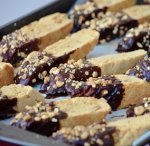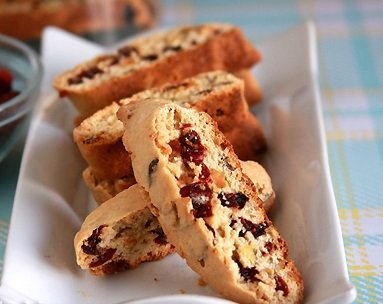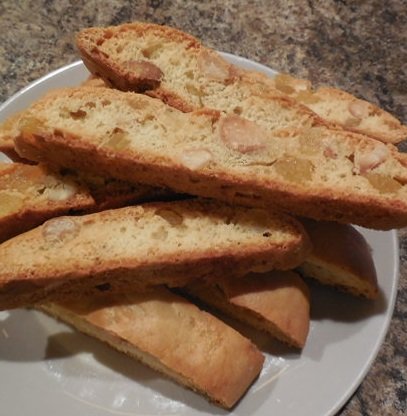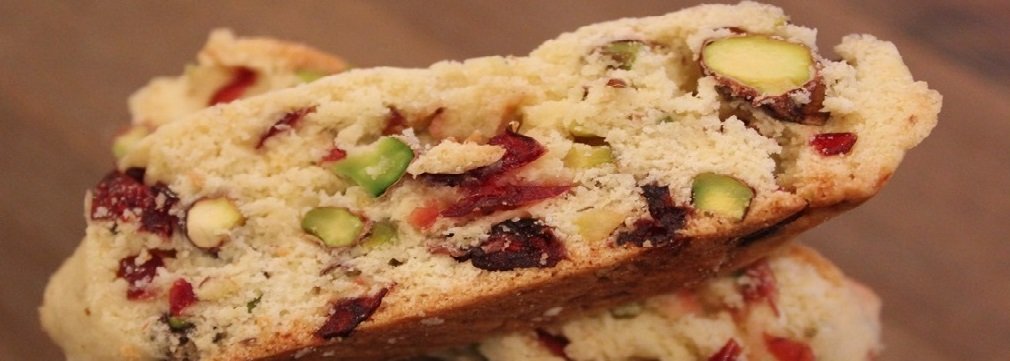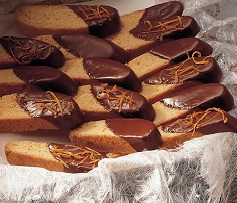Baking Flours
What ingredient do you want to know more about?
Sugars & Sweetners Fats Chocolates Nuts Extracts/Spices
About Baking Flour
There are many different types of flours available in the typical grocery store or supermarket.
All flour made from wheat contains gluten, which is the binding agent that gives baked bread its elastic texture and cake and cookies its fine crumb or airy texture.
For anyone with gluten allergies, see the Gluten Free Guide to flours and ingredients. (coming soon!)
ALL-PURPOSE FLOUR
If you're going to keep just a single type of flour in your pantry, unbleached all-purpose would be it can be use to bake everything from high-rising yeast breads to flaky pie crust and cookies. While you wouldn't use bread flour for pie crust, or cake flour for yeast bread, you can confidently use all-purpose flour, with its moderate protein level, in every single recipe you bake. This is the most common type of flour called for in the recipes on this site.
WHOLE WHEAT FLOUR
For classic robust whole wheat flavor, with all the nutritional benefits of a whole-grain flour-simply can't be beat. This baking flour, is available in both regular and organic versions, both of which are ideal for all your recipes calling for whole wheat. For those who embrace whole wheat, with its rich flavor and dark color, this flour is the perfect choice. Most recipes on this site will call for all-purpose flour; some will call for some whole wheat, for health benefit and/or to impart a nutty natural taste.
ENRICHED FLOUR
In the USA, the law require that all flour not containing wheat germ must have nutrients added back into the flour. Niacin, riboflavin, thiamin and iron are typically added. Some manufacturers also add Vitamins A and D to the flour as well.
WHITE WHOLE WHEAT FLOUR
Want to add the fiber and nutrition of 100% whole wheat flour to your baking—without the strong flavor and dark color traditionally associated with whole wheat flour? White whole wheat flour is the answer.
The mild flavor and light color of white whole wheat make it perfect for all kinds of baked goods, including biscotti. Substitute it for some or all of the all-purpose flour in any of the recipes on this site.
BREAD FLOUR
This baking flour is milled exclusively for yeast baking, and results in high-rising yeast breads. Higher-protein bread flour helps all loaves—from soft white sandwich bread to whole-grain loaves—rise their highest. Bread flour is perfect for any kind of yeast baking; please reserve it for that purpose. It is not a very good alternative when it comes to baking cookie, biscotti or other baked good using baking powder or baking soda to leaven.
SELF-RISING FLOUR
Self-rising flour offers both quality and convenience in one handy package. Southern bakers have relied on self-rising baking flour for years for their biscuits, pancakes, cakes, cookies, muffins, and more. Why use self-rising flour, instead of all-purpose? Self-rising flour is milled from softer, lower-protein wheat, making it perfect for tender baked goods. And it already includes both baking powder and salt, saving you the step of adding those ingredients in many of your favorite recipes. It can be used when making biscotti by eliminating the salt and baking powder in the recipe.
TIP: You can make your own Self-rising baking flour by combining one cup of all-purpose flour with 1.5 teaspoons of baking powder and 1/8 teaspoon of salt. Sift together two or three times.
CAKE FLOUR
Cake flour bakes a moist, tender, high-rising cake with medium-fine crumb. Cake flour yields cakes with fine texture, and a tender crumb. When you're baking a classic golden layer cake, angel food, a chocolate wedding cake, or any cake where delicacy and tenderness are prime attributes, use cake baking flour. You could probably substitute for all-purpose, but expect the lighter flake to the crispiness of biscotti. It does cost more, so unless it is all you have I would stick with all-purpose
RYE FLOUR
Rye is a cereal grain that looks much like wheat but is longer and more slender. Rye's color varies from yellowish brown to grayish green. It is generally available in its whole or cracked grain form or as flour or flakes, the latter of which looks similar to old-fashioned oats. Since it is difficult to separate the germ and bran from the endosperm of rye, rye flour usually retains a large quantity of nutrients, unlikerefined wheat flour. Rye has a very hardy, deep, nourishing taste that does not lend its self to sweet baked goods, like cookies and of course biscotti. However, if you are into savory version of biscotti, you might have fun coming up with your own unique creation.
BUCKWHEAT FLOUR
While many people think that buckwheat is a cereal grain, it is actually a fruit seed that is related to rhubarb and sorrel. Buckwheat flowers are very fragrant and are attractive to bees that use them to produce a special, strongly flavored, dark honey.
Buckwheat is of similar size to wheat kernels, it features a unique triangular shape. In order to be edible, the outer hull must be removed, a process that requires special milling equipment due to its unusual shape. As a flour, buckwheat is available in either light or dark forms, with the darker variety being more nutritious. Since buckwheat does not contain gluten, it is often mixed with some type of gluten-containing flour (such as wheat) for baking. In the United States, buckwheat flour is often used to make buckwheat pancakes, a real delight, especially for those allergic to wheat. But like Rye, buckwheat does not lend its self well to sweet baked goods, but if you are willing to experiment
STORING FLOUR
If flour is stored in its unopened original package, or in an airtight container, it lasts about eight months. Once it’s open, it’s best to keep it in an airtight container or resealable bag. If you store flour in the fridge, it’s even more important to keep it airtight so that it doesn’t absorb moisture or odors from other foods.
The shelf life of the flour will depend on its variety; flours made from whole grains always have shorter shelf life than refined flours. It is best to store whole-grain flours in the freezer, in a sealed container. Be sure to bring it to room temperature before using it.
A word of advice “If the flour doesn’t look or smell right, don’t take a chance”.
For more on GF Baking Flours and baking ingredients Click Here
GLUTEN-FREE MULTI-PURPOSE baking FLOUR
Baking with a carefully crafted blend of GF flour, gluten-free baking isn't a daunting task and in fact can be delicious! No need to mix together the many different flours most gluten-free recipes call for; simply use s GF multi-purpose four.
For more about Gluten Free Baking Flours Chick Here
Questions or Comments?
Like a recipe or something you read? LET US KNOW!
Have a Question don't be shy, ASK US!
Take me from baking flour to:
What's New
-
Almond Anise Biscotti
Jan 12, 15 04:43 PM
Almond Anise Biscotti -
Peanut Butter Biscotti
Jan 12, 15 12:41 PM
If you like peanut butter cookies, you will love these Peanut Butter Biscotti. -
Butterscotch Biscotti
Jan 10, 15 07:24 PM
These decadent Butterscotch Biscotti are made with a bit a extract and lots of butterscotch chips.







